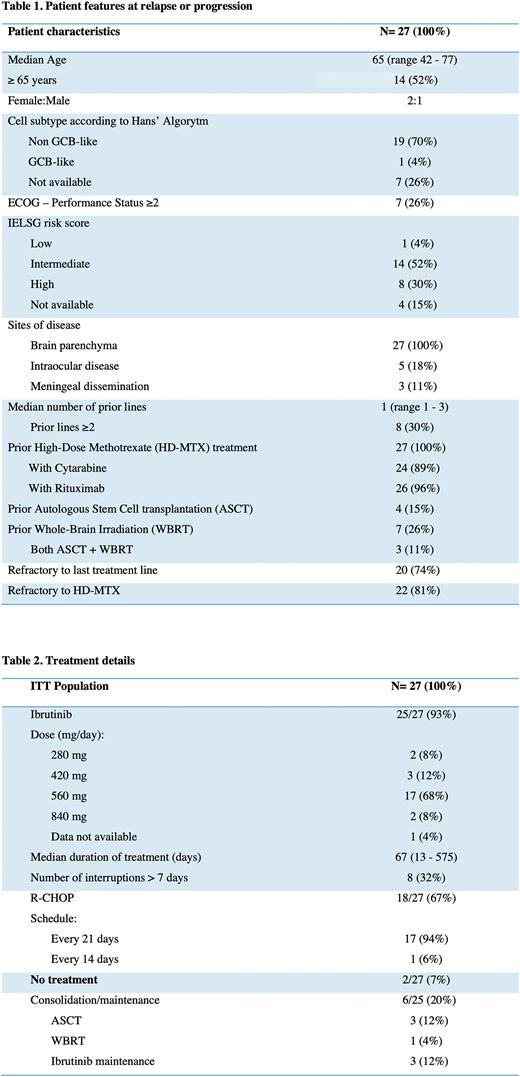Abstract
Background. Patients (pts) with rrPCNSL have poor prognosis, with median survival after relapse (SAR) of 3.5 months. No standard of care exists in this setting and a few drugs showed activity, usually assessed in small prospective series. Ibrutinib (IBR) monotherapy was associated with an overall response rate (ORR) of 47%-77%, with a few cases of complete response (CR), and a median progression-free survival (PFS) shorter than 5 months in two studies on 30 and 13 pts with rrPCNSL [Soussain et al, EJC 2019; Grommes et al, Cancer Disc 2017]. Confirmatory real-life studies are lacking, and the poor efficacy shown by ibrutinib as single drug has prompted physicians to use this drug in combination with chemoimmunotherapy. The choice often fell on RCHOP on the base of phase III PHOENIX trial [Younes et al. JCO 2019], where IBR + RCHOP was associated with a survival benefit in young pts with non-GCB DLBCL, the prevalent phenotype of PCNSL. Moreover, IBR demonstrated a permeabilizing effect on CNS tumor vessels in preclinical models [Meeks et al. NeuroOncol, 2019], posing the rationale for its combination with R-CHOP in rrPCNSL. Herein, we report tolerability and activity of IBR, alone or combined with RCHOP, in pts with rrPCNSL treated in open access program or compassionate use between January 2021 and June 2022 in 15 Italian centres.
Methods. HIV-negative pts with rrPCNSL eligible for IBR and previously treated with a prior line of high-dose-methotrexate (HDMTX)-containing chemotherapy were registered in a retrospective multicenter study and analyzed on intention-to-treat (ITT) principle. Diagnosis of DLBCL was histologically confirmed in all cases. Response and toxicity were assessed and graded according to standardized IPCG criteria [Abrey et al, JCO 2005] and CTCAE v5.0, respectively. ORR was the primary endpoint.
Since the increased risk of invasive fungal infection (IFI) reported in previous studies, physicians used Isavuconazole as antifungal prophylaxis. IBR dose and schedule were based on physician's preference.
Results: Twenty-seven pts (median age 65, range: 42-77; 8 males) were considered (see tables 1 and 2 for pts characteristics and treatment). Twenty-five (93%) pts received IBR, with the addition of RCHOP (I-RCHOP) in 18; two pts died of progressive lymphoma before to start IBR. The median time from relapse to first IBR dose was 30 (range 10-70) days. Sixteen pts completed at least 2 cycles of RCHOP (median 3, range 1-6), while the other two did not because of infectious complications. Grade≥3 hematological and non-hematological toxicities occurred in 13 (52%) and 7 (28%) pts, respectively; all episodes of grade ≥3 toxicity but one occurred in the I-RCHOP group. The first 11 pts were treated without anti-fungal prophylaxis, three of them had IFI, which was lethal in two. Accordingly, the following pts received isavuconazole as prophylaxis, which was associated with a single case of grade-3 fungal infection. The four IFI occurred in the I-RCHOP group. Isavuconazole was well tolerated, with a single case of transient grade-3 toxicity (liver).
The best response was CR in 7 pts (26%) and PR in 8 (30%), with an ORR of 56% (95% CI= 37-75), 13 experienced progressive disease (PD). Six pts with responsive disease (all of them treated with I-RCHOP) received consolidation with ASCT (3), WBRT (1), and/or IBR maintenance (3). At a median follow-up of 15 months (range 2 - 23), 5 responders experienced relapse, 7 remained relapse-free and two died of toxicity while relapse free, with a 1-year PFS and SAR of 26% (95% CI 5-56) and 29% (95% CI 6-54), respectively. Nine pts are alive: 5 (28%) after I-RCHOP and 4 (57%) after IBR alone. Overall, 5 pts (19%) are progression-free ≥12 months, all but one treated with I-RCHOP.
Conclusions: This is the first real-life experience on the use of ibrutinib in pts with rrPCNSL. Two thirds of pts treated with I-RCHOP achieved an objective response, which encouraged physicians to indicate consolidation/maintenance, with consequent durable remission in 19% of pts. New IBR-based combinations should be addressed in rrPCNSL pts. In this setting, isavuconazole prophylaxis should be added to prevent IFI, an important life-threatening complication.
Disclosures
Calimeri:Janssen-Cilag: Consultancy. Nassi:Roche: Membership on an entity's Board of Directors or advisory committees; Takeda: Membership on an entity's Board of Directors or advisory committees; Incyte: Membership on an entity's Board of Directors or advisory committees; Kyowa Kirin: Membership on an entity's Board of Directors or advisory committees; Janssen: Membership on an entity's Board of Directors or advisory committees. Tucci:Takeda: Honoraria; Kiowa Kyrin: Honoraria; MSD: Honoraria; Janssen: Membership on an entity's Board of Directors or advisory committees; Sanofi: Membership on an entity's Board of Directors or advisory committees; Gentili: Membership on an entity's Board of Directors or advisory committees. Ciceri:Kite Pharma: Consultancy.
OffLabel Disclosure:
ibrutinib: treatment of primary central nervous system lymphoma; Isavuconazole: fungal infection prophylaxys in patients with primary central nervous system lymphoma treated with ibrutinib.
Author notes
Asterisk with author names denotes non-ASH members.


This feature is available to Subscribers Only
Sign In or Create an Account Close Modal